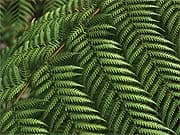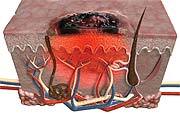Life Extension Magazine®
Novel Plant Compounds Halt PhotoagingNormally you think of protection from ultraviolet skin aging as something that must take place from outside your body, by blocking out solar radiation. But new research reveals that internal factors are just as critical for optimal skin protection. Clinical research shows that upon ingestion, safe and readily-metabolized plant extracts furnish your skin with extraordinary protection from photoaging.1 They slow the absorption of harmful ultraviolet (UV) rays and blunt potentially cancer-causing DNA damage inflicted by sun-generated free radicals.2,3 Much has been written about how the sun’s burning ultraviolet rays harm our health and appearance. Yet despite the warnings, more than two million4 people in the US will be diagnosed with skin cancer this year alone. Rates of melanoma—the most dangerous form of skin cancer—have not only doubled over the past 10-20 years, but continue to rise 3% to 7% annually.5 In one study, novel plant extracts demonstrated an impressive 54% reduction in activity of collagen-degrading enzymes and an 86% inhibition of enzymes that break down hyaluronic acid—your skin’s natural moisturizer!6 In this article, you will learn of the mechanisms by which certain phytonutrients can significantly offset the ravages of excessive UV exposure that lead to premature skin aging. Bolstering Skin DefensesFor centuries, natives of Honduras have protected themselves against sunburn, tumors, psoriasis and other skin disorders by ingesting a fern extract known as Polypodium leucotomos. An initial report on its effects was published in Nature more than 40 years ago7 and since then clinical trials have demonstrated that the antioxidant-rich extract bolsters the skin’s defenses against damaging UV rays. A 2004 study1 by Harvard researchers on nine healthy volunteers tested whether Polypodium leucotomos would protect fair- to light-skinned subjects from sun damage. Some were given oral doses of the fern extract (7.5 mg/kg body weight daily, or about 525 mg for a 154-pound person), some were not, and then all were exposed to different doses of artificial solar radiation. After 24 hours, the researchers took biopsy samples to determine the amount of skin redness due to inflammation (erythema).
The results showed that those who had taken the extract had experienced less UV-induced damage, including “significantly” fewer sunburn cells, indicators of light-induced tissue injury. The extract inhibited the infiltration of mast cells, which release chemicals into the body that cause inflammation, redness, and itching. It also had a protective effect on radiation-sensitive Langerhans cells, key cancer-fighting immune cells found in the outer layer of skin (the epidermis). The Harvard researchers concluded that Polypodium leucotomos is an “effective systemic chemophotoprotective agent.”1 Another study,8 conducted in 2007 by scientists in Milan, Italy, found that Polypodium leucotomos extract was beneficial to those individuals with a high sensitivity to the sun often referred to as “sun poisoning.” Recruited for the trial were 26 patients who suffered from polymorphic light reaction, a condition in which skin rashes can develop after fairly limited sun exposure. Two others had solar urticaria, a rare form of hives caused by exposure to UV light. All subjects had previously not responded to the usual available treatments. Twenty-five of the patients met the criteria for evaluation and were exposed to sunlight while taking an oral dose of 480 mg of Polypodium leucotomos a day. Their responses were compared to their previous experiences to sunlight exposure without the benefit of the Polypodium leucotomos extracts. The researchers reported that the subjects responded well to the fern extract, with 80% of the patients reporting benefit from its use. The “photoprotective activity of Polypodium leucotomos was significant,” wrote researchers. In addition, the fern extract was well-tolerated and did not cause any unwanted side effects. Role in Skin Aging
A recent study found that Polypodium leucotomos could potentially become an important anti-aging ingredient.9 Researchers investigated the effect of the fern extract, which is rich in polyphenols, on human dermal fibroblasts. The scientists studied the impact of Polypodium leucotomos on UV radiated fibroblasts and those that were non-irradiated in vitro. The researchers were particularly interested in the expression of enzymes and transforming growth factor-beta (TGF-beta) that are known to affect the extracellular matrix proteins such as elastin and collagen, responsible for keeping the skin supple and firm. In the study, they looked at how Polypodium leucotomos affects matrix metalloproteinases (MMPs)—enzymes that break down collagen and that are stimulated by exposure to UV light. The study found that Polypodium leucotomos may play a role in preventing skin aging by directly inhibiting MMP expression. At the same time, the fern extract demonstrated its protective effects by stimulating certain types of collagen. Interestingly, Polypodium leucotomos stimulated collagen production and it also decreased its degradation by the MMPs. Why Fern Extract is EffectiveOver the years, researchers have studied whether antioxidants such as oral tocopherol (vitamin E), ascorbate (vitamin C), and carotenoids are effective in protecting against the sun’s ultraviolet rays.10,11 Studies have showed varying results, some more promising than others. However, when any photo-protective effect was observed, it usually was after prolonged administration of the antioxidants.12 So why is Polypodium leucotomos more effective than other antioxidants? In an article published this April,3 Dr. Salvador Gonzalez, a renowned physician-researcher in dermatology and photo-medicine at Memorial Sloan-Kettering Cancer Center, reviewed several proposed mechanisms by which the natural ingredient appears to work:
Polypodium leucotomos not only has short-term effects such as inhibiting reactive oxygen species (free radicals) production and DNA damage, but the short-term effects “translate into long-term prevention of photoaging and photocarcinogensis,” Dr. Gonzalez said.3 He noted that since Polypodium leucotomos can be administered orally it could decrease the incidence of phototoxicity in individuals with difficult-to-treat skin disorders such as psoriasis and vitiligo (loss of pigment in patches of the skin) who are undergoing UV treatments.3
New Combinations Offer More ProtectionInterestingly, combinations of various antioxidants have been found to have synergistic effects, yielding formulations that are more beneficial than any of the individual compounds used alone.14 Studies have shown that when several antioxidants are combined in one skin care product, the benefits to skin may be greater, and the photoprotective effect increases.15,16 For instance, it’s well known that sun exposure is not the only cause of accelerated skin aging. Stress can also damage our skin, the body’s largest organ, as well as various other body parts.17 Reducing stress may therefore be significant in improving overall skin condition. In a double-blind, randomized, placebo-controlled, in vitro study, a proprietary preparation containing Indian gooseberry (Phyllanthus emblica) and ashwagandha extracts demonstrated a 54% inhibition of enzymes that break down collagen, and an 86% inhibition of those that break down hyaluronic acid, the skin’s natural moisturizer.6 While ashwagandha helps protect the skin against the effects of stress, it also helps to benefit stress-related health conditions. In a randomized, double-blind, placebo-controlled trial, 98 chronically stressed adults were assigned to receive a patented standardized extract of ashwagandha for 60 days. They received either 125 mg once or twice a day, 250 mg twice a day, or a placebo. Their stress levels were measured throughout the study and blood pressure was taken at the beginning and at the end of the study.18
The researchers found that all three groups taking the ashwagandha reduced their stress and anxiety and lowered their blood pressure levels. The group receiving the lowest dose of 125 mg once a day had a 62% reduction in anxiety compared to those with the placebo, with anxiety scores declining even further in the other two groups. In addition, the group receiving the daily dose of 125 mg showed a 14.5% reduction in cortisol levels and a 13.2% increase in DHEA, with the other two groups reporting significantly greater benefits. In addition, all three groups taking ashwagandha saw a definite drop in their levels of C-reactive protein, which is a measure of inflammation within the body. The researchers concluded that the “daily use of Withania somnifera (also known as ashwagandha) would benefit people suffering from the effects of stress and anxiety without any adverse effects.”18 In response, Polypodium leucotomos has recently been combined with a patented form of Phyllanthus emblica (from the Indian gooseberry) and ashwagandha—a medicinal herb that has been used for thousands of years by Ayurvedic practitioners. Rich in flavonoids and steroidal lactones called withanolides, ashwagandha works as an adaptogen to relieve the damage that emotional stress can inflict on skin.3,6,19,20 SummaryMost of us fail to recognize the age-accelerating effects of everyday sun ray exposure to the skin. Just ten minutes a day of normal sun exposure is the equivalent of intentionally bathing in the sun for over an hour every week.
Sun self-defense is crucial to prevent skin cancer, skin aging, and immune system suppression. Even when using a sunscreen, many of us are less-than-perfect, inconsistent appliers of topical protection. Polypodium leucotomos is a tropical fern plant with potent antioxidant and anti-inflammatory properties that scavenges free radicals, protects DNA, and provides significant protection against other UV dangers. Polypodium leucotomos, when taken orally, works as a skin protector at a deep cellular level. This fern extract, along with Indian gooseberry and ashwagandha, however is not meant to substitute for topical sunscreens and should not give anyone a false sense of security about their sun exposure. If you have any questions on the scientific content of this article, please call a Life Extension® Health Advisor at
| ||||||||||
| References | ||||||||||
| 1. Middelkamp-Hup M, Pathak MA, Parrado C, et.al. Oral Polypodium leucotomos extract decreases ultraviolet-induced damage of human skin. J Am Acad Dermatol. 2004 Dec;51(6):910-8. 2. González S, Pathak MA, Cuevas J, Villarrubia VG, Fitzpatrick TB. Topical or oral administration with an extract of Polypodium leucotomos prevents acute sunburn and psoralen-induced phototoxic reactions as well as depletion of Langerhans cells in human skin. Photodermatol Photoimmunol Photomed. 1997 Feb-Apr;13(1-2):50-60. 3. Gonzalez S, Gilaberte Y, Philips N. Mechanistic insights in the use of a Polypodium leucotomos extract as an oral and topical photoprotective agent. Photochem Photobiol Sci. 2010 Apr;9(4):559–63. 4. Rogers HW, Weinstock MA, Harris AR, et al. Incidence estimate of nonmelanoma skin cancer in the United States, 2006. Arch Dermatol. 2010 Mar; 146(3): 283-7. 5. Available at: http://www.medscape.com/viewarticle/470300_2. Accessed May 3, 2010. 6. NutraGenesis LLC. Data on file. 2008. 7. Horvath A, Alvarado F, Szöcs J, de Alvardo ZN, Padilla G. Metabolic effects of calagualine, an antitumoral saponine of Polypodium leucotomos. Nature.1967 Jun 17; 214(5094):1256-8. 8. Caccialanza M, Percivalle S, Piccinno R, Brambilla R. Photoprotective activity of oral polypodium leucotomos extract in 25 patients with idiopathic photodermatoses. Photodermatol Photoimmunol Photomed. 2007 Feb;23(1):46-7. 9. Philips N, Conte J, Chen YJ, et al. Beneficial regulation of matrixmetalloproteinases and their inhibitors, fibrillar collagens and transforming growth factor-beta by Polypodium leucotomos, directly or in dermal fibroblasts, ultraviolet radiated fibroblasts, and melanoma cells. Arch Dermatol Res. 2009 Aug;301(7):487-95. 10. Eberlein-Konig B, Placzek M, Przybilla B. Protective effect against sunburn of oral combined systemic ascorbic acid (vitamin C) and D-alpha-tocopherol (vitamin E). J Am Acad Dermatol.1998 Jan;38(1):45-8. 11. Stahl W, Sies H. Carotenoids and flavonoids contribute to nutritional protection against skin damage from sunlight. Mol Biotechnol. 2007 Sep;37(1):26-30. 12. Sies H, Stahl W. Nutritional protection against skin damage from sunlight. Annu Rev Nutr. 2004;24:173-200. 13. Villa A, Viera M, Amini S, et al. Decrease of ultraviolet A light–induced “common deletion” in healthy volunteers after oral Polypodium leucotomos extract supplement in a randomized clinical trial. J Am Acad Dermatol. 2010 Mar;62(3);511-3. 14. Greul AK, Grundmann JU, Heinrich F, et al. Photoprotection of UV-irradiated human skin: an antioxidative combination of vitamins E and C, carotenoids, selenium, and proanthocyanidins. Skin Pharmacol Appl Skin Physiol. 2002 Sep-Oct;15(5):307-15. 15. Stahl W, Heinrich U, Jungmann H, Sies H, Tronnier H. Carotenoids and carotenoids plus vitamin E protect against ultraviolet light-induced erythema in humans. Am J Clin Nutr. 2000 Mar;71(3):795-8. 16. Palombo P, Fabrizi G, Ruocco V, et al. Beneficial long-term effects of combined oral/topical antioxidant treatment with the carotenoids lutein and zeaxanthin on human skin: a double-blind, placebo-controlled study. Skin Pharmacol Physiol. 2007;20(4):199-210. 17. Buljan D, Buljan M, Zivković MV, Situm M. Basic aspects of psychodermatology. Psychiatr Danub. 2008 Sep;20(3):415-8. 18. Biswajit A, Hazra J, Mitra A, Abedon B, Ghosal S. A standardized Withania somnifera extract significantly reduces stress-related parameters in chronically stressed humans: A double-blind, randomized, placebo-controlled study. JANA. 2008;11(1):50-6. 19. Chen TS, Liou SY, Chang YL. Antioxidant evaluation of three adaptogen extracts. Am J Chin Med. 2008;36(6):1209-17. 20. Padmavathi B, Rath PC, Rao AR, Singh RP. Roots of Withania somnifera inhibit forestomach and skin carcinogenesis in mice. Evid Based Complement Alternat Med. 2005 Mar;2(1):99-105. 21. Walsh N. Polypodium leucotomos for skin protection. Internal Medicine News. 2006 May 1. 22. Alcaraz MV, Pathak MA, Rius F, Kollias N, González S. An extract of Polypodium leucotomos appears to minimize certain photoaging changes in a hairless albino mouse animal model. A pilot study. Photodermatol Photoimmunol Photomed. 1999 Jun-Aug;15(3-4):120-6. 23. Philips N, Smith J, Keller T, Gonzalez S. Predominant effects of Polypodium leucotomos on membrane integrity, lipid peroxidation, and expression of elastin and matrixmetalloproteinase-1 in ultraviolet radiation exposed fibroblasts, and keratinocytes. J Dermatol Sci. 2003 Jun;32(1):1-9. 24. Available at: www.skincancer.org/understanding-uva-and-uvb.html. Accessed April 26, 2010. 25. Titus-Ernstoff L, Perry AE, Spencer SK, Gibson J, Ding J, Cole B, Ernstoff MS. Multiple primary melanoma: two-year results from a population-based study. Arch Dermatol. 2006 Apr;142(4):433-8. |







